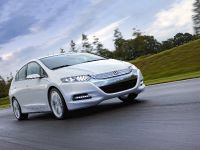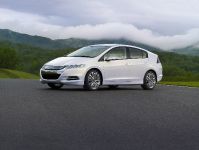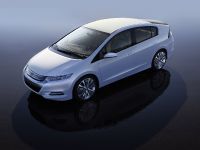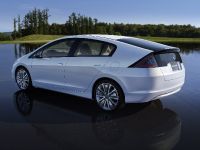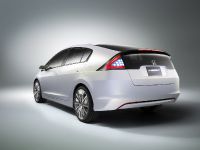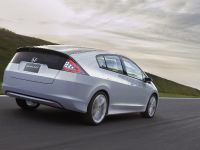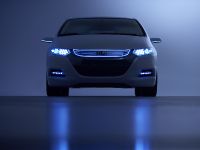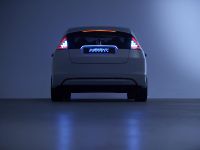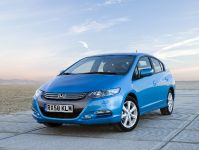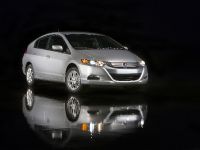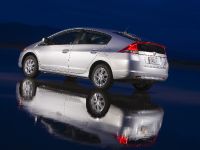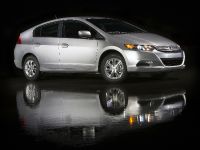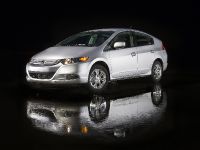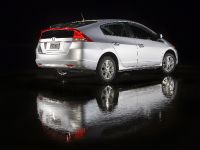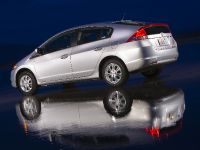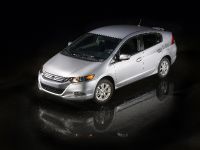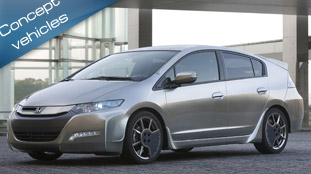Honda Insight
Honda first marketed the original Insight Hybrid in 1999 and has been working on the technology for almost two decades.
The motivation behind pursuing this technology is fundamental and basic, avoiding waste. In simple terms, the energy from braking on a car with a conventional drivetrain is lost by being converted into energy that disappears into the atmosphere as heat and noise. The task Honda's R&D engineers set themselves was to harness this energy to the benefit of the customer and the environment.
One decade on, Honda is launching a new Insight that takes those core principles and extends them, allowing a customer to carry their family and luggage in an efficient, flexible and affordable vehicle.
The Direction of the Honda Insight The aim was to make petrol-electric technology available to more people by developing a family hybrid car that was more affordable.
The Insight is a 5-door hatchback with Honda's IMA hybrid system that offers low-emission, fuel efficient motoring in a practical, no-compromise offering -to make an attractive, lower cost package.
Honda expects this car to have a significant impact on the industry. Because the Insight will be more affordable to more people, it makes cleaner car technology accessible to a completely new group of car buyers - opening the hybrid market to a new section of society.
That's why the main aim in the development to reduce the size, complexity and price of components and systems to drive that final retail price down. Honda wants to bring hybrid technology to a wider market, but knows that the price, or the perceived price, of cleaner cars has prevented some car buyers from even looking at them seriously. Honda wants those people who've never considered buying a hybrid car to try one for size.
It is one thing to develop an ultra-green product, that only the affluent can afford, but in its quest to be a company that society wants to exist, Honda challenged its engineers to build a hybrid for everyone.
Making it Affordable The Insight is the culmination of over 20 years of hybrid development and more than 35 years of lower impact petrol engine development, which started with the CVCC engine in 1972.
That experience and technical knowledge has enabled Honda to develop the components and parts in our IMA system so they can be produced at a lower cost.
Honda has also been building production hybrids for a decade. In that time, a lot has been learnt about the production of electric motors and other key parts of the hybrid system. This understanding has led to improved production equipment and techniques, which will reduce production costs. And because the major hybrid components are produced in-house, this also helps to control overall costs.
"Our engineers have shown great tenacity and skill in reducing the cost of our IMA system to allow us to reduce the build costs of the Insight. By using so many components that are manufactured in-house, we have the ability in the market to continuously refine our processes in a way an outside supplier might not." Yasunari Seki, Insight Large Project Leader
The plan to produce and sell a much larger number of hybrid cars than before leads to economies of scale, and thus a lower final cost per unit. To achieve these numbers, a new electric motor production line has been added to the Suzuka factory, in Japan, which will double its per hour production capacity for IMA motors.
There are also specific product developments that helped keep the costs down:
1. 95 per cent of the IMA unit was redesigned to reduce both size and cost 2. It was a bespoke model, so any additional costs required to ‘shoe-horn' technology into an existing model (eg. Civic Hybrid) were eliminated 3. The platform and chassis share many components with that of the new Jazz
All the cost-saving doesn't mean cutting corners or compromising on performance or durability. Engineers have focussed on finding engineering solutions to drive costs down, developing the most efficient hybrid technology at the lowest possible cost to the customer.
The Motivation for Building an Affordable Hybrid A key part of Honda's global philosophy is to be "a company that society wants to exist". And while that may at first sound like another piece of marketing strategy speak, it is a mantra that is followed the world over, starting with the R&D centres.
This philosophy helps explain why the marketing of a more affordable hybrid car; it's part of Honda's efforts to have a positive impact on society.
Honda could have chosen to place this cleaner technology in high-end cars; showpiece environmental machines to sell at a premium rate to a low number of customers. There's probably an argument that says there's more money per unit in that approach.
However, in line with Honda's philosophies, beliefs and heritage, the approach was to bring low emission hybrid technology to the masses by using our engineering experience to reduce the costs and therefore the retail price.
As well as introducing new sections of society to cleaner cars, this should also help increase the sales volume of hybrid cars - which will have a positive effect on overall emissions figures, and therefore the environment.
Fuel Consumption and Emissions Improvements The fuel economy (combined) is 4.4 l/100km, while CO2 emissions are as low as 101g/km.
Honda has concentrated on developing a car that will deliver better fuel economy in the ‘real world', taking into account the actual conditions in which the car will be driven by their customers.
Honda would rather concentrate on delivering the kind of economy customers can see and experience every day, whether driving with the heater and head lights on during the winter or with the stereo pumping and the air conditioning hard at work heat of the summer. These are the real world working environments in which the Insight has been designed to excel.
Honda has produced an affordable, efficient, exceptionally frugal and low emission car but there are styles and techniques of driving that can be employed to take even greater advantage of the hybrid technology. The Eco Assist system developed for the Insight, will train drivers, helping them achieve the best possible fuel economy.
The Insight's unique driver coaching system marks a new era of motoring where manufacturers and individual drivers share responsibility for their final fuel consumption.
Target Customers Because the Insight is designed to bring hybrid technology to a wider audience, equally Honda expects the car to appeal to a broad customer base.
The majority of customers will be new-to-hybrid, traditional C-sector customers that are looking to replace their conventional family car with a more efficient one. They may have deemed a hybrid too expensive previously, but will appreciate the Insight's roomy proportions and low running costs, as well as the outright purchase price.
For the same reason, Honda expects some existing hybrid customers and owners of more conventional, low CO2 models to move across into the Insight, making the most of the advancements in cost-reducing technologies.
Please refer to Image 01_ENVIRONMENT.JPG for Environmental awareness across the EU27.
Sales Targets Honda aims to sell 200,000 Insights each year.
Global sales are planned at 200,000 units with the US taking 100,000 of these cars.
As CEO and President, Mr Fukui has already announced, hybrids will make up 10 per cent of Honda's total car sales by the middle of the next decade and to achieve this target, Honda will also launch a sporty hybrid (based on CR-Z) and a Jazz Hybrid over the next few years. With these four hybrid cars, Honda is targeting to sell over 500,000 hybrids globally per year.
Hatchback Practicality and Aerodynamics "The reason we chose a 5-door hatchback was that we wanted the car to be popular in Europe," says Yasunari Seki, Large Project Leader. "American Honda - the biggest market - asked us to build a car with a boot, but we insisted on a hatchback, because to compete with other green cars and sell more in Europe, it had to be a 5-door design. Of course, aerodynamically it is also a more favourable shape."
Exterior Styling As a low emission hybrid car, it was important for the Insight's design to express its environmental credentials. It had to look like a ‘green' car but it also had to appear dynamic and fun to drive.
Above all, the Insight had to appeal to a broad range of people globally and another important factor related to this was the body style itself. Customer research showed that 5-door body shapes were most popular, and so this layout was chosen to appeal to as many people as possible.
Thirdly, the Insight takes many styling cues from the FCX Clarity. This was deliberate to position the Insight as a recognisable, global car with green credentials as well as the aerodynamic advantages of the body shape.
CO2 Emissions During Building, Use and Disposal As a matter of course, Honda carries out a Life Cycle Assessment (LCA) Programme for all of its vehicles which looks at the CO2 emissions at each stage of a car's life cycle, including production.
Honda developed this programme in 2007 to introduce a product specific LCA system to investigate the volume of CO2 emissions associated with the whole life cycle of each Honda vehicle. This allows Honda to compare the environmental impact of the manufacturing stage and indeed the whole life cycle of their hybrid cars.
The findings demonstrated two things, the importance of the ‘use stage' in a car's life cycle CO2 emissions, and that there is very little difference between the CO2 emissions associated with the raw material and production stages of hybrids compared to conventional cars. (see images 02_ENVIRONMENT.JPG & 03_ENVIRONMENT.JPG). This means that the overall CO2 emissions throughout the life of a hybrid vehicle will be significantly less than those of a conventionally powered car.
Where will the Insight be built? The Insight will be produced at Honda's Suzuka factory in Japan where a new hybrid motor production line has been added to double the motor production capacity.
When does it go on sale? The Insight will go on sale in European Market from Spring 2009.
Honda's green heritage
1972 The CVCC engine is developed- the world's first low-emission petrol engine that meets strict US clean air act regulations without a catalyst
1986 The CR-X coupe becomes the first mass-produced 4-cylinder to break the 5.6l/100km (50mpg) barrier
1993 Honda wins prestigious World Solar Challenge with the solar-powered Type Dream car. A new and improved Type Dream was built for the 2006 Challenge and won again
1997 Honda started sales of EV Plus electric vehicle - capable of carrying four adults nearly 140miles on a single charge - in the US and Japan and sold more than 200 units by the year 2000
1997 Honda unveils the Civic GX, which runs on natural gas and is available to buy in America. It becomes the world's cleanest internal combustion engined car of that era
1999 Honda launches the Insight - a petrol-electric hybrid car capable of 3.4 l/100km (83mpg) on the combined cycle, with emissions of just 80g/km of CO2
1999 Honda shows the first version of the FCX with its revolutionary, zero emission, fuel cell power source
2003 Civic IMA hybrid saloon is launched, with CO2 emissions of 116g/km
2006 New Civic Hybrid goes on sale, with fuel economy of 4.6 l/100km (61.4mpg) (combined) and emissions of 109g/km
2006 Honda started production and sales of Civic and Fit FFV, capable of running on 100% biologically derived bio-ethanol fuel.
2007 A lightweight hybrid sportscar concept, named CR-Z, is revealed at the Tokyo Motor Show, and a version is confirmed for production
2008 The hydrogen fuel cell-powered Honda FCX Clarity rolls off the production line in Japan, and leasing of these zero emission vehicles starts in the US
2009 Reviving the Honda Insight name, a more affordable hybrid car will go on sale in Europe in the spring - making cleaner motoring technology available to more people
Other green initiatives
* In 1956, founder Soichiro Honda said: "After materials are carried into the factory, nothing but products should be carried out." The result is zero waste to landfill at all manufacturing plants worldwide by 2010. Nearly all Honda factories, including all in Japan and the UK, have achieved this target already.
* Since 1976 Honda has planted roughly half a million trees around its factories, absorbing over 4000 tonnes of CO2 and making over 3000 tonnes of oxygen.
* In 1989 Honda started introducing water-based paint, which seems like a small detail, but when you use as much as they do, the details count. Fortunately it caught on.
* The lessons learned from Honda's record-breaking Solar Car were put to good use and Honda started developing really efficient and thin-film solar panels for houses, and factories.
* Fourteen factories, including Suzuka where the Jazz and Insight are built, have been equipped with the next-generation thin-film solar panels, producing electricity with zero CO2 emissions.
* Honda don't just make clean engines, we make clean engines cleanly. What's more, they've been doing it for a long time. For instance:
o A cogeneration system installed at Kumamoto Factory in July 2006 completed the installation of cogeneration at all Honda's factories in Japan. The cogeneration unit provides efficient electric generation, while the cogeneration unit's exhaust gas produces steam and hot water, used in the Kumamoto's motorcycle painting operations. The result is a reduction of approximately 1,039 tons of CO2 emissions in 2007 alone.
o Guangzhou, the Zengcheng Factory, which began production in September 2006, features an industry first: 100% recycling of water. Achieving zero-emissions of wastewater, the facility has saved an estimated 170,000 tons of water so far.
* Honda developed the Home Energy Station as a potential solution to the hydrogen infrastructure problem. The current version runs on natural gas and a solar energy version is being tested. The units not only refuel the FCX Clarity, but heat and power the home, and return any surplus energy back to the electricity grid.
* The hydrogen-powered FCX Clarity, is the world's first zero-emission fuel cell production car. It's currently available for lease in the US and Japan and emits only water from its exhaust.
* Honda initiated a beach clean-up project to help reduce pollution of some seashores. A specially developed and lightweight beach cleaner is towed by an ATV, allowing for clean beaches.
* Considering the potential of a global food shortage in future, Honda chose rice as a research subject over six years ago. Since then they have been at the forefront of identifying genes that significantly increase the yield of rice plants. A gene named Gn1a helps to increase the number of grains, while another gene, sd1, can now be isolated to reduce the height of the plants, making them less likely to topple over and spoil. Koshihikari rice bred with both these genes demonstrates a 23 per cent increase in crop yields. Meanwhile, they've also discovered a gene that dramatically improves the regeneration ability of rice, making it much easier to breed new varieties that surpass the potential of Koshihikari.
* To confront the rapid deforestation in China, Honda is supporting the Desert Planting Volunteer Association in its Joyful Forest Initiative, which aims to cultivate forest in the desert.
* Since 2003, Honda has been helping Brazilian people conduct their own environmental education initiatives. The projects include river clean-ups and art and craft workshops to re-use PET bottles and newspapers.
Mr Fukui Green technology pioneer "As a university student in the 1960s, I was working on my senior thesis - an analysis of nitrogen dioxide emissions. I had recognised the issue of emissions as an important theme - it was probably the first NO2 study in Japan.
I admit that one of the reasons I did this study was because I wanted to join Honda. Honda was famous for challenging new things and this appealed to me. In 1969 I achieved my goal and joined Honda in the same year that Soichiro Honda pulled out of motorsport to focus all its energy on meeting the clean air challenge.
When I joined the company I embarked on a race to develop the technology that could improve the quality of the air we breathe. My first project was emissions research for a catalyst system and I tried a new concept which had never been used before. Unfortunately, it didn't work and it actually made the exhaust more toxic, but under Mr Honda's instruction, who was still running R&D at that time, we made more attempts.
I remember Mr Honda began yelling at me. He was passionate about meeting this challenge, and after we failed again, he said: ‘Don't just think about a system, to treat the exhaust like a catalyst. Think about making a clean engine system from the beginning'.
From then on the team and I began developing an engine that produced fewer emissions without a catalyst.
After selling cars for just a few years, in November 1974 I visited the United States for a certification test at a government emissions lab. In that test, to the disbelief of many, the Civic became the first vehicle to pass the new standards of the U.S. Clean Air Act based only on engine performance.
What's more, the government inspector congratulated me on achieving the industry's top rating for fuel economy, which came as a surprise given we had not even been thinking about fuel efficiency.
Since this landmark achievement in the US, Honda has continued to work on technologies that make cars cleaner and more efficient. Now, over 35 years later, Honda is able to bring to market the most affordable hybrid ever."
Takeo Fukui, President and CEO, Honda Motor Company
Pricing and affordability Honda's own research has shown that most drivers think hybrids are more expensive, and that's stopping them adopting the cleaner engine technology.
In a most recent public survey, of those who wouldn't consider a hybrid vehicle, 40 per cent said price is the main reason they are put off.
Some hybrid cars have even been branded elitist, within reach of only the affluent - an image perhaps not helped by celebrity-endorsement campaigns.
Honda's research, and that of other manufacturers, has also shown that while many people have good intentions to be greener, when it comes to buying cars, it's cost, rather than climate that's influencing purchase decisions.
"Three quarters would buy a lower emission car if it meant lower bills ... Six out of ten people say the most important consideration when choosing a lower emissions car is its running cost." BMW Report, Driving Change, October 2008
For most drivers, hybrid cars have been viewed as an expensive alternative to petrol and diesel models, akin to a status symbol rather than an efficient, cleaner mode of transport.
The new Insight is designed to alter such perceptions, and will make hybrid technology available to more people, including a new set of car buyers that would never have considered a hybrid before.
Downsizing With the world in the grip of an economic downturn, the trend for downsizing is expected to continue, with more people moving from thirsty larger vehicles into smaller, more efficient machines.
A poll on one motoring website showed that two thirds of car buyers will opt for a greener car next time around. However the vast majority said the main reason was to save money, not necessarily to be green.
For all these customers, Insight offers the best of both worlds - a practical family car, with strong environmental credentials and plenty of financial benefits including a lower outright purchase price to suit more pockets.
Running cost savings Added to its lower initial cost, the Insight offer many running cost savings including reduced tax burden, congestion charge exemptions and fewer trips to the filling station.
Hybrid or Low Emission Incentives
Ireland:
| C02 bands | C02 g/km | Vehicle Registration Tax rates |
| A | 0-120g | 14% |
| B | 121-140g | 16% |
| C | 141-155g | 20% |
| D | 156-170g | 24% |
| E | 171-190g | 28% |
| F | 191-225g | 32% |
| G | 226g+ | 36% |
In addition hybrids receive €2500 rebate on the registration tax that is paid. Annual road tax is in the lowest band at €104 per year.
France: 2000 € directly deducted from Retail Price by dealer (private) €700 (company car)
Portugal: -50% on sales tax
Netherlands: Up to €6400 purchase tax relief for hybrids (dependent on fuel efficiency). CO2 (P<110/D<95g/km): 50% discount on road tax
Luxembourg: CO2<120g/km: €750 tax bonus
Norway: For sales tax calculation:
* No kW tax on electrical engine
* 25% car weight, before calculation of weight tax (compensation of battery pack)
Sweden: 10,000SEK rebate to private individuals who buy a green car ( hybrid, ethanol, <120g CO2/km) - Corporate -40% benefit tax
Austria: Revise (Jul08) of car sales tax (NoVA),
* Full Hybrid (>1km electric only drive): €500 bonus (also applied for E85, CNG, LPG & H2 vehicles)
* CO2: <120g/km €300 bonus / >180g/km €25/g malus (malus border to be reduced to 160g/km from 2010)
Switzerland: Incentives difference between Kantons:
* TypeA Hybrid: discount of VAT calculated on 50% of the vehicle price
* TypeB Hybrid: one-time incentive for CHF 5,000 ( IMA)
* Type C Hybrid + 3l cars: one-time incentive for CHF 1,000
Italy: Incentive of up to €2800 for ecological car (includes hybrid)
Spain: 2 regions Andalusia and Castilla Leon up to 2000 € and 1890 € support respectively. And 75% discount - civil servants
Belgium: Tax incentive (SRP is calculation base)
* If car < 105g/km CO2: -15% tax (max. 4,350€)
* If car < 115g/km CO2: -3% tax (Max. 810€)
Greece: No Sales Tax for Hybrid Vehicles
Hungary: Fixed lower Reg Tax for Hybrid
Slovenia: No sales tax on vehicles emitting <110g
Finland: CO2 based car reg tax (%) = 4 + CO2/10
EXTERIOR DESIGN
Although the design team started with a blank piece of paper - in that this was a brand new model with no history - they faced many challenges in creating the exterior appearance of the Insight.
On the one hand, as a low emission hybrid car, it had to express environmental credentials - it had to look like a ‘green' car - but on the other hand it had to appear dynamic and fun to drive; part of Honda's key design principles. Above all, in line with the positioning of Insight, the design had to appeal to a broad range of people.
"We wanted the car to be widely accepted," says Creative Chief Designer, Motoaki Minowa. "If we just created an environmentally-friendly car it could have looked dull, or boring. We wanted to insert a sporty factor to make the car more appealing - and after all, sportiness is in Honda's DNA."
While the ‘greenness' of the car may have challenged the sporty direction of the overall design, in some areas it actually helped the dynamic cause. Because the newly-developed IMA system is more compact, it meant the nose of the car could be shorter, creating a snubbed, more aggressive look to the front end.
Another important factor that led (and to some extent restricted) the exterior design was the bodystyle itself. To appeal to as many people as possible, a 5-door layout was chosen, and this brought its own challenges, particularly when optimising the aerodynamics of the car, and creating enough headroom for passengers in the rear (see Aero Athlete, p14).
"The reason we chose a 5-door hatchback was that we wanted the car to be popular in Europe," says Yasunari Seki, Large Project Leader. "American Honda - the biggest market - asked us to build a car with a boot, but we decided on a 5-door design because to compete with other green cars and sell more in Europe, it had to be a 5-door hatchback. Of course, aerodynamically it is also a more favourable shape."
One thing that didn't restrict the area of design was the budget, even though the rest of the project was so concerned with reducing costs. If anything, the development team spent more money getting the appearance of the car right. Adding an extra window to the rear quarter, for example, was costly, but was essential in creating a sleeker look. "The car had to be stylish and make its owner feel proud," says Mr Minowa.
Many will have noticed the similarity in the overall shape and look of the Insight to its fuel cell cousin, the FCX Clarity. As well as the aerodynamic advantages of this shape, Mr Minowa says there's a definite reason for mimicking the body style of the advanced hydrogen-powered car.
"We intentionally tried to make the Insight look like a baby version of the Clarity," he says. "There are some design treatments and colouring effects we have taken from the FCX, but basically the car's shape is very similar. FCX Clarity is the leader, the most advanced car, the ultimate clean car - and we want the Insight to follow that lead. In a way, because the new Insight takes design cues from the old car and from the FCX, it is bridging the gap between the past and the future."
Lights The Insight adopts slim, projector-style headlights in a 4-light cluster. The headlight's low beam has blue detailing, and the indicators are located in the lower bumper face.
At the rear, the Insight uses LEDs for the taillights and stop lamps. LEDs consume less power, which aids fuel economy. But rather than just replacing bulbs with LEDs, the designers attempted to ‘spread the light' through the design of the taillight unit and the use of reflective surfaces.
While there were many considerations and factors that affected the exterior design, it was aerodynamics that most governed the shape and look of the Insight.
Making the car as slippery as possible exaggerates the already frugal hybrid technology on board the Insight, increasing fuel economy. So the design team set about creating a shape that had minimal drag. Elsewhere we've spoken about the similarity in the exterior design to that of the FCX Clarity, but that likeness is closest when the two cars are viewed in profile. It's clear that the rear sections of these two cars are almost identical in shape - and for good reason.
Firstly, the line from the centre of the roof to the top of the boot lid is at the optimum angle for controlling the flow of air off the top of the car, with minimum turbulence. Also, you'll notice that the top half of the body tapers in towards the rear of the car, which also helps the air flow travel smoothly over the car. Stable air flow over this section helps the car pass through the air with minimal drag.
"The concept for the main shape of the car is called ‘Aero Athlete'," says Mr Minowa. "It reflects a sporty, lean body with no fat, the tension of muscles and nothing unnecessary added."
The shape of the tailgate is also very important - again, compare the Insight's boot to that of the FCX Clarity, or CRZ, or even the original Insight. They all share the same shape and lines to help the aerodynamics.
"We learnt a lot about aerodynamics from the first Insight," says Mr Minowa, Creative Chief Designer. "From the B-pillar back the two cars are very similar, but we couldn't have radical optimisations like the covered wheels, for example, as this Insight had to have more appeal."
The lower body sections are much wider, which also helps the aerodynamic qualities, and provides a stable, wide stance - giving the car a more masculine appearance.
Paint There are eight exterior paint colours: Spectrum White Silver Pearl, Cerulean Blue Metallic, Alabaster Silver Metallic, Polished Metal Metallic, Neutron Blue Metallic, Crystal Black Pearl, Urban Titanium Metallic and Milano Red.
Aero Athlete This was the overall design theme for the exterior appearance of the Insight. Aero stems from the desire to minimise drag and reduce frontal area, while retaining an attractive and sporty character. The shape has been tested repeatedly in a wind tunnel and was effectively shaped by the wind. The athlete part of the concept refers to a taut, honed body, without unnecessary weight or excessive bulk. Dynamic visual tension forms in the panels of Insight like muscle of an athlete. The sensuous shape of "Aero Tail" is formed by Aerodynamics and as similar shape can be seen on the rear of the FCX Clarity and the original Insight models.
The shape of cabin is integrated into the bonnet and flows into the shape of front grille which enhances the bold hexagon shape of the lower part of the bumper. The front design incorporates the identity of FCX Clarity to recognize the fuel cell car's status as an environmental pioneer.
CHASSIS
The Insight chassis is newly designed, but in the quest to produce an affordable car with compact dimensions, it is based on components used for the latest Jazz - and as such, it shares some components (suspension brakes and steering) and characteristics with the supermini. From the starting point of Jazz, engineers devised a package that accommodates the hybrid system, provides space for adults to sit in comfort and allows room for the impressive load space.
The structure of the engine compartment and front section of the car is almost identical to Jazz, with some minor alterations to aid crash protection, but behind the front bulkhead the platform is unique to Insight. The wheelbase is 2550mm (50mm longer than that of the Jazz).
Upon this platform, front and rear suspension from the Jazz are used, which means MacPherson struts at the front, and an H-shaped torsion beam at the rear to keep the load floor low, increasing luggage capacity inside.
Dynamically, the goal was to achieve pliant, but stable handling performance in a range of conditions and on a mixture of road surfaces.
Relocating the fuel tank Although it shares many commonalities, perhaps the most significant difference between the Jazz and the Insight platform is the position of the fuel tank. Many of you will be familiar with the Jazz's distinctive central tank layout, under the front seats, which helps make the car so versatile, but on the Insight platform, the decision was taken to put the fuel tank under the rear seats.
This meant that the seating for occupants could be mounted lower in the car, resulting in a lower roof, smaller cross-section area, and thus a more aerodynamic body shape, which assists fuel economy at high speed.
Brakes The braking system comprises of front and rear discs matched with ABS, Electronic Brake Force Distribution (EBD) and Brake Assist as standard equipment.
Honda engineers concentrated on delivering effective stopping power with a linear, natural feel to the pedal, both in normal daily use and when heavier braking is required.
Wheels and tyres The Insight is fitted with a seven-spoke alloy design, to enhance the sporty image of the car.
Vehicle Stability Assist (VSA) All Insight grades are equipped with Honda's Vehicle Stability Assist (VSA) system, designed to assist the driver in maintaining control during cornering, acceleration and sudden manoeuvres by applying braking to the right or left hand wheels as necessary and managing the engine torque systems.
At its simplest level, VSA has a traction control function whereby it detects wheel slip under acceleration and coordinates the use of braking and engine torque to regain traction. In situations where the driven wheels are on surfaces with different levels of traction, such as a partially wet road surface, the system applies braking action to the wheel that's slipping, allowing the tyre with better grip to move the vehicle. In addition, the system reduces engine output to minimise wheelspin.
An indicator light flashes on the instrument panel while the system is actively enhancing the stability of the vehicle. A cockpit switch to the side of the instrument panel is provided to disable the VSA.
Warranty The Insight is covered by a 3-year / 144,000 km standard warranty, 3-year surface corrosion warranty, 5-year exhaust system warranty and 12-year structural corrosion warranty - plus, a unique 8-year warranty for the entire IMA system, including high-power battery.
ENGINE, MOTOR AND TRANSMISSION
Honda's IMA hybrid system concept is now 10 years old - having made its debut in the original Insight back in 1999. IMA stands for Integrated Motor Assist, which consists of a low-friction 1.3 litre engine that serves as the primary power source, an ultra thin electric motor, a lightweight and compact battery with a continuously variable transmission. (see Why IMA?, p19).
This system has been used successfully in not only the Insight, but also the Civic IMA, and its successor, the Civic Hybrid. Over the years the system has evolved and become smaller, more lightweight and less expensive to produce, and the latest version in the new Insight is the most advanced IMA technology introduced by Honda to date. The fifth generation IMA system in the Insight is 24% more compact than the fourth generation system freeing up space for luggage.
The engine itself is new, but is based heavily on the 1.3-litre from the Civic Hybrid. This modified i-VTEC unit from the Civic Hybrid has been further enhanced with lessons learned from the Jazz incorporated to improve fuel economy. The low friction, pattern coated piston design has been combined with a new catalyst design to further optimise this already highly efficient power unit. These measures along with a further stabilised combustion process give a fuel economy improvement for the engine alone of 2% on what is already a highly-efficient unit.
During deceleration, when the engine's cylinders have no load on them and so combustion in all four cylinders is stopped and each pot is sealed shut. This virtually eliminates the pumping losses, decreasing resistance to allow the motor/generator to operate more efficiently and increase energy recovery to charge the battery.
The technology used to shut the cylinders, VCM (for Variable Cylinder Management), is also used to shut all four cylinders when only little torque is required - during low speed cruising for example. In this mode the Insight is powered by the electric motor only, with the pistons running idle.
In addition, virtually everything possible has been done to the engine to reduce friction, including an offset crankshaft/connecting rod design, plateau honing of the cylinders for a smoother surface and a second low friction piston ring.
On its own, the engine produces 88PS and 121Nm of torque, but the key to hybrid systems is the support given by the electric motor that can help boost performance as well as keep emissions and fuel consumption to a minimum.
What is a hybrid? Hybrid is the combination of a petrol engine with an electric motor. The battery that powers the electric motor charges itself up with regenerative energy from deceleration and braking. Therefore the Insight never needs to be recharged from an external power supply. The integrated electric motor assists the engine by giving it a boost during acceleration to improve fuel economy. The hybrid system also runs the car's systems at idle and shuts off the combustion engine to reduce emissions, so when a driver stops in traffic the engine falls silent.
The result is a car that behaves like a petrol-engined car in terms of performance, emits less CO2 than an equivalent diesel and delivers excellent fuel economy.
Electric motor As well as a new engine, the Insight gets a new, improved motor which uses coils with high-density windings and high-performance magnets to produce 14PS and 78 Nm. But the real step-forward with the motor has been its size and shape - the latest version is much thinner than the motor in the current Civic Hybrid (35.7mm vs 61.5mm), which means the entire IMA system is more compact and lightweight.
Improvements have also been made to the high-power battery, which is located under the boot to help lower the centre of gravity. The IPU is smaller and lighter than that found in the Civic hybrid, with size reduced by 19% and weight by an impressive 28%.
The cooling system for the battery has been much improved, which means it's more efficient in its use of power, and can feed it to the electric motor more often. A motor on the side of the battery pack draws through air from pipes leading to intakes outside of the rear seat bolster in the car (on the Civic Hybrid, the air intake is on the parcel shelf, which can be obstructed).
The recovery speed of the battery has also improved, meaning that with power from regenerative braking, it can charge more quickly and therefore deliver power to the electric motor more regularly.
Performance When combined, the motor and engine produce lively performance ideal for urban environments, with good throttle response and acceleration times to rival conventional 1.6-litre petrol cars with automatic gearboxes. The Insight reaches 100 km/h from a standing start in 12.6 nds, and goes on to a top speed of 186 km/h.
Transmission Using a CVT transmission in a hybrid provides smooth and predictable gear transitions and helps keep the IMA system operating in its most efficient range. In the Insight, an evolution of the high-torque CVT unit from the Civic Hybrid is used.
This version of CVT has a lower final drive gear ratio (4.200 from 3.937), which results in faster-acting initial acceleration performance.
The start clutch control has been redesigned to take full advantage of the characteristics of the IMA motor that delivers more torque at lower revs. By engaging at lower revs to enhance initial acceleration and contribute to fuel efficiency.
Also, for the first time on a Honda hybrid, the Insight benefits from paddle shifts, so quick gear changes can be made from levers just behind the steering wheel.
Emissions/economy Of course, one of the major benefits of hybrid powertrains is that they can reduce exhaust emissions and boost fuel economy. And when the systems are placed within a purpose-built, aerodynamic body, the advantages are enhanced. The Insight performs well in government emissions and economy testing, achieving 101g/km and 4.4 l/100km (combined) - but that's not the whole story.
Life Cycle Assessments As a matter of course, Honda carries out a Life Cycle Assessment (LCA) Programme for all of its vehicles which looks at the CO2 emissions at each stage of a car's life cycle, including production.
Honda developed this programme in 2007 to introduce a product specific LCA system to investigate the volume of CO2 emissions associated with the whole life cycle of each Honda vehicle. This allows Honda to compare the environmental impact of the manufacturing stage and indeed the whole life cycle of their hybrid cars.
The findings demonstrated two things, the importance of the ‘use stage' in a car's life cycle CO2 emissions, and that there is very little difference between the CO2 emissions associated with the raw material and production stages of hybrids compared to conventional cars.
The Insight will be produced at the Suzuka plant, the same as the Civic Hybrid as well as many non-hybrid products.
Please refer to image 02_ENVIRONMENT.JPG &03_ENVIRONMENT.JPG in the images section.
Why IMA? While all hybrid cars have both an internal combustion engine and an electric motor, there are three main types of technology offered by different manufacturers. The first is the Series hybrid, which is driven solely by an electric motor. A combustion engine is used to generate electricity to power the motor.
The second type is called a Parallel hybrid, which uses the petrol engine as the main source of power to drive the car. The electric motor sometimes assists the engine, and at times even powers the car on its own. This is the system used by Honda hybrids - the system we call Integrated Motor Assist).
The other kind of hybrid is known as Series Parallel, or Combined hybrid. This is the type used by the Toyota Prius, and as you've probably guessed by the name, it uses elements of both the parallel and series hybrid systems. This system has a two electric motors and an engine, and each can be used independently of one another.
Each system has its advantages and disadvantages, but the biggest benefit of a parallel system, like IMA, is that it's much smaller and lighter than the others. It also tends to be less expensive to produce. Honda has focussed on optimising the parallel system over the past decade, which helps it to bring Insight to the market at a lower price.
IMA systems have proved to be very reliable in the hands of our customers who have been using them in the original Insight, Civic IMA and Civic Hybrids for almost a decade. It is often said that being the first to buy a new technology is risky, but customers like Mr. Partridge from the UK who completed over 160,000 trouble free kilometres in his first Insight would disagree. Now those early pioneers are being joined in embracing hybrid technologies by big corporate enterprises like Eurostar and British Airways who have added Civic Hybrids to their respective fleet's to lower their carbon footprints.
Real World fuel economy As has been discussed, the principle aim of the development of Insight was to produce an affordable hybrid car, and to find engineering solutions to reduce costs. This was the direction, rather than concentrating efforts, and spending more money, on driving emissions and economy below a certain level.
Honda is pleased to have been able to reduce emissions and improve economy over Civic Hybrid, while making the IMA system smaller, lighter and less expensive to produce.
As a result, the Insight's fuel consumption on the combined cycle is 4.4 litres per 100km, with emissions as low as 101g/km
The aim of Insight development was not just to concentrate on good homologation figures, but to deliver good figures in every day driving. "We have various ways of improving the figures, if it's only the figures you want to achieve. But they do not relate to the real world." Yasunari Seki, Large Project Leader
Of course, achieving better fuel consumption not only helps customers in their every day car use, but it helps reduce the impact of the Insight on the environment.
Eco Assist A few years ago, while monitoring customer use of the Jazz, the Insight development team found that there were significant differences in the fuel economy achieved from one driver to another. For example, at an average speed of 30km/h (20mph), there were differences of up to 21 per cent in the actual fuel consumption being recorded by different drivers. With this in mind, the engineers tweaked the car's management system in an attempt to minimise the effect of varying driving styles on fuel economy. When the tests were repeated, the least efficient drivers improved their results, and the difference between all the results was reduced to 12 per cent.
Honda has taken these learnings into the development of Insight, and the result is the ECON switch. When activated by the driver, this switch tells the car's management system to adopt specific settings to improve fuel consumption. It does this without affecting overall safety levels or the general usability of the car.
When the ECON switch is depressed, the Insight enters a ‘super economy' mode, resulting in the following:
* Power output is limited and torque is reduced by 4 per cent (except when the driver presses the pedal to the floor)
* Smoothes driver accelerator input to optimise throttle position and engine speed. At any engine speed, there is an optimum throttle angle, which if maintained, results in the best fuel efficiency. But some drivers apply a more on/off approach to throttle control, often pressing the accelerator down too far. To counteract this, the system ‘smoothes out' driver input by maintaining the throttle opening to match the speed and conditions. The driver can override the system at any time, to perform an emergency manoeuvre, for example
* Smoother CVT shift pattern
* Regenerative brake energy is increased
* Idle stop time is increased
* Air conditioning operates more frequently in the recirculation mode
* The fan blower power is reduced more frequently to limit the system's consumption of energy
* During Idle Stop mode (the engine turning off when the car is stationary), the air conditioning shuts down.
The ECON button A few interesting facts about that helpful green switch:
* ECON stands for Effective CONtrol
* The different sections of the symbol are designed to reflect a tree growing
* If you turn the tree symbol on its side, the symbol reads ‘ECO'
Eco Guidance "Our work as engineers is not just to develop and deliver products to our customers - it is also to devise ways to help them use those products even better." -Yasunari Seki, Large Project Leader of Insight.
While the petrol-electric IMA system is already incredibly efficient in its use of fuel, there are driving styles and techniques that can be employed to take greatest advantage of the hybrid technology.
Driving as smoothly as possible, without heavy acceleration or braking, reduces excessive fuel consumption and allows the high-power battery to remain charged, which in turn means it can power the electric motor to support the engine more regularly, resulting in greater fuel economy. And driving without a heavy right foot generally equals better fuel consumption anyway.
That may sound easy in theory, but in practice it can be tricky to change the way you've been driving, in some cases for decades. Honda is not expecting everyone to know how to drive like an eco-warrior - or indeed, to have to monitor the way they drive to get more miles from a tank of fuel.
Instead, Honda has developed some useful technology to help Insight owners become more efficient behind the wheel. It's called Eco Assist, and it does what it says on the tin.
The great thing about Honda's Driver Coaching technology is that it's not a fixed set of rules to follow, or a limit on what you can and can't do as a driver. It's a simple system that rewards the driver if they adopt a certain driving style.
Together with the ECON switch, the guidance function can be used to achieve high fuel economy and thus minimise harmful exhaust emissions.
During driving, there are two main elements to the system: an ‘eco drive bar' indicator within the black and white Multi Info Display (MID), and an ambient meter behind the digital speedometer display. Both instruments are synchronised, to give ‘real time' information on the consumption of fuel and provide guidance on how you should alter your driving style
The ‘eco guide bar' in the MID is a solid bar symbol that moves to either side of a central line. The idea is to drive in a way that keeps the bar in the centre and away from the shaded/dotted areas on either side.
When driving smoothly, and thus efficiently, the bar stays near the centre of the indicator, shifting slightly right during gradual acceleration and slightly to the left when braking gently. During these conditions, the ambient meter behind the speed display glows a green colour to show optimum economical driving performance.
Under greater acceleration, or when braking moderately, the bar in the MID shifts more towards either end of the scale, showing the use of more fuel, and the ambient meter glows a green/blue colour.
With aggressive acceleration, or sudden braking, the indicator bar will head to the right or left, deep into the shaded areas of the scale to show major fuel consumption and the ambient meter turns blue respectively.
In order to achieve the best fuel consumption figures, the driver should aim to keep the bar in the centre, and the display glowing green as much as possible throughout each journey.
To help motivate Insight drivers during each journey, another display above the bar indicator grants rewards for more efficient driving. If performing well, small leaves will ‘grow' above the bar to show the driver's eco-progress, with more leaves and eventually a flower added if the system records a ‘perfect' score.
Also, by pressing the Info button on the steering wheel, and scrolling through the MID displays, drivers can not only look at their average mpg of the current trip, but can also retrieve their average fuel economy of the last three journeys.
Eco Scoring Once a journey is over, and the ignition is turned off, the black and white ‘eco guide' in the MID changes to an ‘eco score' display. Now, the leaf symbols at the top report on the driver's performance during the last drive, while the bar and symbols at the bottom of the display show a lifetime score. This is shown in three stages with the fully grown tree and flower to the right of the bar showing the best score.
If the driver's stage has improved since the last journey, a recognition symbol with wreathes is displayed. At the end of the third stage a trophy symbol appears indicating good progress.
Conversely, if the driving style is worse, and the lifetime score and stage regresses, then the recognition symbol of a withering plant is displayed.
VERSATILITY
As the Insight will bring hybrid technology to a completely new audience, its design had to be versatile enough to meet the demanding requirements of such a varied customer base. Be it transporting the children, grandchildren, grandparents or carrying shopping to gardening equipment, the Insight can fit it all in.
Load space In terms of boot for your buck, the Insight stacks up well. Relocating the smaller, more compact IPU (high-power battery pack) under the floor of the cargo area means there is 400-litres of luggage space (VDA). This rivals most C-sector competitors, exceeding luggage capacities of several of the key players.
As on the latest Jazz and Civic, a sunken well under the cargo floor provides an additional 8-litres storage space - an ideal space for items that are wet and need to be kept separate or for possessions that need to be concealed.
For larger loads, the 60:40 split folding rear seats fold down to open up a 584-litre flat load area. As in the latest Jazz, integrated headrests mean the rear seats drop down easily, without needing to remove the headrests or adjust the front passenger seat.
The boot floor can be configured in two different ways to accommodate different loads. For large items like pushchairs, suitcases, golf bags or trolleys it can be kept in the normal flat position, making best use of the boot's ample dimensions. Alternatively, the cargo floor can be dropped down to a lower position, creating a large rectangular recess (as on Civic) capable of carrying taller items or shopping bags and things prone to rolling around.
The 8-litre storage well beneath the boot floor can be accessed in either configuration by lifting the small rectangular cover. And there's an additional storage compartment on the left hand side of the boot also.
The tonneau cover can be pulled taught to conceal the boot contents. However, to accommodate taller items it can be stored just under the floor board in the fittings specially provided.
Cabin storage The designers have squeezed every inch of possible storage space out of the Insight. There are six cup/bottle holders spread throughout the cabin - two integrated into the wide and spacious door bins, two in the rear doors and two cup holders ahead of the gear stick. In front of the front cup holders there is a detachable partition box useful for storing sunglasses, mobile phones and other smaller items.
The armrest storage box between the driver and front passenger houses the USB port (ES models only) for this purpose, an iPod pocket can also be found inside the storage box. As well as room for CDs, keys and other items better kept out of sight, there's a rubber band on the underside of the lid to hold sunglasses in place.
Storage recesses for smaller items can be found in each of the doors behind the electric window buttons and another right below the audio system for keys fobs, cards and smaller items best kept away from prying eyes. All models feature a passenger seatback pocket.
INTERIOR
The Insight has been designed to comfortably accommodate five passengers, cleverly packaged within an aerodynamic shell.
Within this sleek exterior, the Insight can still boast headroom and tandem distances among the best in class and rival many medium sized cars.
An inviting and airy interior has been created with clever designs that give an increased sense of space, and practicality.
Convex shapes have been used wherever possible to reduce mass of the interior plastics and create a sense of space, particularly where passengers sit. This moves away from the traditional interior design rules that mainly dictate concave surfaces.
For instance, the front dash is split into two distinct sections. The lower light-coloured section is convex and curves away from the driver and front seat passenger giving a greater sense of space and leg room while the upper, darker section surrounds the front occupants, the driver in particular, to give the feeling of a cockpit-style cabin.
Special attention was paid to outward visibility. Forward visibility is excellent thanks to slim A-pillars, large front door window surfaces that do not require a separate pillared front quarter window, and the same cabin-forward design used for the latest Jazz. Equally, the integrated window in the boot enables good low, rearward visibility, allowing the driver to see a low post, or child behind the vehicle. In addition, retractable rear headrests and rear three quarter lights increase rearward visibility.
Generous specification High quality, tactile materials, stylish designs and tasteful colours have been used throughout the cabin. Plastics have a soft-touch leather-like appearance and fabrics are plush and comfortable.
Two interior upholstery colour combinations are available - dark royal blue with cream or warm, creamy beige. Seats are covered in two textured fabrics - a dotted pattern for the seating and soft suede-like material for the side bolsters. All models are equipped with active headrests for greater safety.
The steering wheel is fully adjustable for reach and rake to ensure drivers of all heights can be accommodated. A slim armrest and dead foot rest are also provided for extra comfort.
Also fitted as standard across the range are one-touch indicators for easy lane changing on motorways, an adjustable driver's seat, foot rest, passenger seat back pocket and vanity mirrors for both driver and front passenger.
Instrument panel The two-tiered instrument panel allows the driver to focus on the important information - the speedometer above the steering wheel and the main instrument panel directly below it.
The fascia comprises of four main indicators - a large rev counter, flanked by the petrol gauge and motor assist gauge. The automatic gear selected is displayed within the rev counter. As on the Civic Hybrid the motor assist gauge shows, during driving, whether the electric battery is being charged e.g. during regenerative braking or whether the electric motor is assisting the petrol engine e.g. during hard acceleration.
A useful LCD multi-information display set within the centre of the rev counter provides information such as instant and average fuel economy, range, outside temperature as well as other displays to encourage more economical driving techniques. The information button on the steering wheel allows the driver to flick through the different information displays.
All instruments are located on or around the steering wheel, within easy reach for the driver.
ECON system The green ECON button can be found on the dash, to the right of the steering wheel. When switched on the ECON system indicator appears in the top left of the instrument panel. The LCD display also indicates whether the system is active and serves as a coaching system by providing additional information to help the driver maximise economy.
Air conditioning In automotive air conditioning units there is a cooling circuit involved that delivers a refrigerant to a condenser and evaporator thus delivering cool air to the cabin. This process involves a compressor and with it associated thermal, mechanical and pumping losses, which affect fuel consumption.
To improve the thermal efficiency of the air conditioning system on the new Insight, Honda engineers have expanded the usable thermodynamic range compared to conventional systems. Ingeniously, the piping layout is changed with the low pressure cold pipe enclosing the high pressure hot refrigerant pipe which has a scroll type groove on the, which means the cold refrigerant on its way back to the engine bay helps cool the warm refrigerant travelling to the cabin. The indentation on the outside of the inner pipe is in a spiral arrangement, which increases the surface area and therefore the efficiency of the heat transfer between the outer and inner tubes. This principle improves the thermal efficiency of the air-conditioning system and as a result, less effort is required from the compressor, resulting in improvements to fuel consumption.
Air conditioning in ‘Idle Stop' mode When driving the Civic Hybrid, during ‘Idle Stop' mode the air conditioning could still be operated, thanks to an extra electric motor powered by the high-power battery pack. However, to save costs, this function has not been included on the Insight. Instead, to keep the occupants comfortable, the length of the idle stop time is limited. However, when ECON button is pressed, a longer idle stop time is set for improved efficiency.
Audio systems All models are equipped with a single CD/audio system, four speakers, steering wheel mounted audio controls and auxiliary jack with MP3/WMA/AAC playback capability. In addition, some models are fitted with a USB port, located in the centre arm rest/storage box which enables fifth generation or later iPods (including Nanos), plus a variety of other digital audio players, to be played through the Insight's main audio system. MP3 players docked via the USB port can also be controlled using the steering wheel mounted audio controls and depending on type, will charge once connected.
Satellite Navigation The voice-activated satellite navigation system is a touch-screen unit utilising a fully updateable DVD for all data. The Honda navigation features 11 text languages, including: English, German, Italian, French, Spanish, Portuguese, Dutch, Danish, Swedish, Norwegian and Suomi. Five of these, English, German, Italian, French and Spanish can be used for voice activation and spoken guidance instructions. The Insight's system allows the user to find a wide range of places of interest, including restaurants, petrol stations, airports and Honda service centres. The majority of points of interest include phone numbers where appropriate for added convenience. Where it is available, the Honda navigation system works with traffic information to alert customers to potential delays and navigate a route round them.
Hands-Free Telephone (HFT) ES grades will also be equipped with Hands Free Telephone (HFT) kit, which uses Bluetooth technology to allow mobile phone calls to be made safely on the move.
A series of speakers and microphones installed in the car can connect to any Bluetooth-enabled communications device, even in a bag or briefcase.
The HFT system allows the driver to automatically transfer a call onto the HFT once the ignition has been turned to the ACC position. The user can also utilise the phone's keypad to make calls as well as storing up to 50 names with a speed-dial number. More importantly all numbers can be accessed by HFT.
Thanks to the satellite navigation, it is also possible to import the phone books of up to six separate mobiles via the Interface Dial, up to 1000 names with a potential of 10,000 numbers. Once imported, numbers are accessed by selecting ‘search imported phonebook' on the screen, followed by a keyword search or by listing all records.
Safety Two ISOFIX fittings in both the right and left rear seats are provided together with tether anchor points provide secure child seat mounting points and ensure correct installation.
INSIGHT TECHNICAL SPECIFICATIONS
|
ENGINE |
1.3 SOHC i-VTEC |
|
|
2 valves per cylinder |
|
Bore x stroke |
73 x 80 |
|
Capacity |
1339 |
|
Compression ratio |
10.8 |
|
Max. power (Engine) |
65/88 |
|
@ rpm |
5800 |
|
Max. torque (Engine) |
121 |
|
@ rpm |
4500 |
|
Max. Power (Electric Motor) |
10.3/14 |
|
@ rpm |
1500 |
|
Max. torque (Electric Motor) |
78.5 |
|
@ rpm |
1000 |
|
Fuel system |
Honda PGM-FI Electronic Injection |
|
Fuel rating |
Unleaded, 95 RON |
|
ELECTRICAL |
|
|
Battery |
12V 35Ah |
|
Alternator |
85A |
|
DRIVETRAIN |
|
|
Front-wheel drive |
CVT |
|
Clutch |
Multi-plate wet clutch |
|
Gear ratios |
3.172-0.528 |
|
SUSPENSION |
|
|
Front |
MacPherson struts |
|
Rear |
Torsion Beam Axle |
|
STEERING |
|
|
Type |
Rack and pinion, electrical power assisted |
|
Turns lock to lock |
3.29 |
|
TURNING CIRCLE |
|
|
At wheels |
- |
|
Wall to wall |
11.0 |
|
BRAKES |
|
|
Front |
Ventilated discs (262mm) |
|
Rear |
Discs (260mm) |
INSIGHT TECHNICAL SPECIFICATIONS
|
DIMENSIONS, WEIGHTS, CAPACITIES |
|
||
|
Overall length |
mm |
4395 |
|
|
Overall width |
mm |
1695 |
|
|
Overall height |
mm |
1425 |
|
|
Wheelbase |
mm |
2550 |
|
|
Ground clearance |
mm |
146 |
|
|
Luggage space |
litre |
408 |
|
|
Kerb weight |
kg |
1204 |
|
|
Max. permitted weight |
kg |
1650 |
|
|
Fuel tank capacity |
litres |
40 |
|
|
FUEL CONSUMPTION (1999/100/EC) |
|
||
|
Urban |
l/100km |
4.6 |
|
|
Extra Urban |
l/100km |
4.2 |
|
|
Combined |
l/100km |
4.4 |
|
|
CO2 emissions |
g/km |
101 |
|
|
PERFORMANCE |
|
||
|
Top Speed |
km/h |
186 |
|
|
Acceleration 0-100km/h |
|
12.6 |
|
|
WHEELS AND TYRES |
|
||
|
Wheels |
15x5.5 |
16x6 |
|
|
Tyres |
175/65R15 |
185/55R16 |
|
All data is in-house data and is subject to change upon homologation. All data refers to cars equipped with 15-inch wheels.
All information correct at time of going to print.
INSIGHT ACCESSORIES
Exterior Accessories
Exterior decoration Honda presents various decorative exterior accessories which highlights the design and bodywork of the Insight. The front bumper garnish consists of high-strength plastic and is available in crystal black. It fits the car's bodywork and adds a stylish accent to the Insight. The B-pillar decoration has a defined metal look and features the Insight logo. The door handle covers also have a metal look, and they cover up the pocket behind the door handle. The front, rear and side skirts are available in matching body colours, are fully integrated in the car's bodywork, and highlight the aerodynamic design of the Insight
Alloy wheels Honda offers a 15" Crystal design and 16" Cronos and Turbine design alloy wheels. The Crystal alloys come with a clear coat surface and a window with Kaiser Silver. The Cronos alloys have a full colour coat with a chrome surface, while the Turbine wheels have a clear coat surface with a Blade Silver window. All Honda wheels have passed extensive testing in the research as well as the development stage and match European car homologation.
Front, rear & side body trims Made of soft material and with a flexible paint finish, these trims will protect the bodywork from any annoying scrapes and scratches that may occur in city traffic. The trims are available in the car's body colour.
Four front and Four rear parking sensors Integrated into the front and rear bumpers, a set of parking sensors will protect the car and enable customers to swing into the smallest of parking spaces with no fuss.
Interior Accessories
Interior decoration panels To give the Insight an individual touch, stylish interior decoration panels have been created. The panels match the steering wheel and contain a centre panel, passenger dash panel, front and rear door panels rings in a dark metal finish and outlet rings in a bright metal finish.
Blue ambient light The blue ambient light illuminates the front foot area and centre console and adds to the relaxed atmosphere inside the car.
Front and rear doorstep garnish A stylish doorstep garnish gives extra protection and adds a subtle but classy detail to your car. It comes in stainless steel and features an embossed Insight logo.
Audio & Electronics
Honda Compact Navigation System The newly developed widescreen portable navigation system is also designed to complement the car's interior. Its attachment fits perfectly onto the dashboard; no more suction cups falling down and almost no wiring on show. It includes full European mapping, and the latest European Points-of-Interest including a complete list of Honda car & motorcycle dealers. Optionally, it comes with a TMC antenna for up-to-date traffic information. The unique anti-glare back reduces distracting windscreen reflections. Extra features include Bluetooth wireless technology, WMA/MP3 function, JPEG viewer & audio book player.
Rear Entertainment System The new portable Rear Entertainment System is perfectly in style with the Insight's interior and is installed in the back of the front seat(s), not interfering with the active headrests. It offers the option of adding a second monitor on the passenger side. A compact remote control is included & wireless headphones are available in two sizes. The Rear Entertainment System can also be used outside the car.
Honda Hard Disk Drive Navigation The Honda HDD Navigation System sets a new benchmark in in-car navigation and entertainment. It features a 40 GB Hard Disk Drive to pack a host of navigation functions, and boasts powerful image and sound capabilities. Its high-performance navigation engine processes and displays the map data in a flash. The map content can simply be updated via the built-in SD card reader. Or the system can be used as a private jukebox by using the Music Catcher to store favourite tunes in the unit's memory. The HDD Navigation System also offers 2-Zone capabilities and is compatible with Bluetooth®-enabled mobile phones.
Bluetooth® Phone System The Bluetooth® Phone System is a simple, safe and convenient hands-free solution, which allows easy management of calls while keeping focused on the road.
